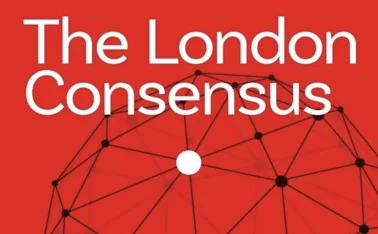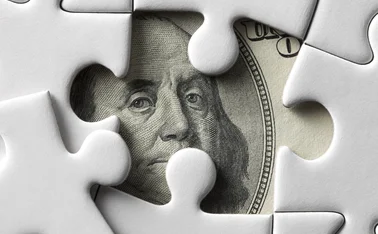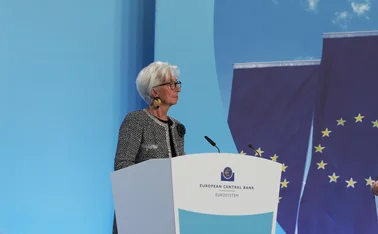
Stability under the 2% inflation standard is a chimera
An inflexible standard of value that lets the market decide how much money to produce would be superior, write Brendan Brown and Robert Pringle.

Central banks promise to ‘restore stability’ under their mandate – the 2%-a-year inflation standard – after the great pandemic and war inflation of 2021–22. We question, however, whether this is feasible. We also argue that the inflation standard – indeed, the current monetary regime, as a whole – has shown itself to be deeply flawed.
Take views about the US Federal Reserve System. Consumer price index (CPI) inflation in the US (as well as the Fed’s favoured price index for personal consumption expenditure) is now on a downtrend and will likely be returning to target (2% per annum) by late 2023 where it is supposed to ‘stabilise’. There are similar views about the policy outcomes for the European Central Bank, the Bank of England and the Bank of Canada, among others, with rates of increase and levels adjusted for their specific circumstances. Restoring ‘price stability’ is supposed to be the centrepiece of a broad return to more ‘normal conditions’ in financial markets and interest rates. On this reading, the 2% inflation standard will emerge triumphant.

Brendan Brown (left) and Robert Pringle, the founder of Central Banking, are co-authors of the 2022 book, A guide to good money: beyond the illusions of asset inflation.
But does the record prove that the standard, as practised since the early 1990s, is worth ‘restoring’? We argue that the average 2% CPI inflation outcome (in North America and Europe) during the regime’s first quarter-century (until the eve of the Covid-19 pandemic) does not constitute evidence of its intrinsic merit. On the contrary, the period provides evidence of the monetary malaise typical of a flawed monetary regime. There is evidence of ‘money getting out of control’, including asset inflation, and the malinvestment and other distortions that accompany this. Various ‘real factors’ camouflaged the symptoms of monetary inflation – money supply running consistently ahead of underlying demand for money – in goods and services markets. So, these showed up typically in raging asset price inflation.
Under the camouflage
Let us divide the period into phases. Look more closely, for example, at the period from 1995–2005, when the IT revolution and related productivity miracle as well as the entry of China into the world economy (and the related terms of trade improvements for the rest of the world) helped to keep reported CPI inflation ‘low’. True, but monetary inflation showed up, instead, in virulent asset inflation. Apparently ‘normal’ interest rates were, in fact, on average well below the level consistent with sound money at a time of an economic productivity upsurge. They were indeed far from ‘normal’ (interpreting this to mean rates in line with an absence of monetary inflation or deflation).
In other words, central banks adopted the 2% inflation standard at a time (the mid-1990s) when the natural tendency of consumer prices under a sound money regime would have been to fall gradually. This natural rhythm downwards resulted from the impact of real income gains from economic progress on the demand for money (so with money supply growth constrained, price falls will be in line with money supply and demand in balance). Central bankers found themselves fighting against this natural rhythm to meet their new mandates. Monetary policies stimulated price rises by increasing the money supply above underlying demand for it. Their chosen path for policy interest rates put market rates below where they would otherwise have been (in a freely determined market, under tightly constrained money supply). This fuelled asset inflation in the following 10–12 years.
Monetary inflation resumed after the global financial crisis of 2008–09 (ahead of which both the Fed and other central banks had been administering disinflation during a late cycle CPI inflation spike). Here again, coincidental factors were at work holding down the reported rate of CPI inflation. In the early years, say from 2010–13, policy changes to the structure of the monetary system raised the demand for money. In the crisis, deposit insurance was increased (the limit doubled in the case of the US), and then, crucially in late 2008, the Fed started paying interest on reserve deposits while Treasury bond yields were manipulated down by application of the regime’s notorious ‘non-conventional’ toolbox, including quantitative easing (QE). Re-capitalisation of banks was also a factor adding to the appeal of the bank component of money. In all, this meant that rising supply of money, especially base money, met a step increase in money demand, restraining for a time the rise in CPI inflation.
When a recession threatened late in 2014 and early 2015, the Fed administered another dose of monetary inflation, abandoning plans for raising rates from zero and for ‘quantitative tightening’. This monetary injection continued in 2016, an election year, under then chair Janet Yellen (in office since early 2014). True, concerns that continued low interest rates and prospective big business tax cuts could cause inflation to accelerate produced a hawkish turn to policy through 2017–18. But this did not last. Monetary policy again became accommodative as evidence accumulated that the US economy was suffering from a decline in economic dynamism – in reality, a side-effect of the monetary drugs administered in the previous two decades and the associated misallocation of capital investment and rise of monopoly capitalism.
Thus, coincidental factors largely explain why reported CPI inflation remained low in Europe and North America (flat in Japan) in the quarter century before the pandemic. It is unlikely that such a pattern will repeat itself. Episodes during which the natural rhythm of prices is downwards, whether due to productivity spurts, structural surges in money demand, for example, in the long run occur roughly to an equal extent to episodes in the opposite direction. It was the luck that in its first quarter century, the first type of episode was preponderant – and, even so, that luck turned into the misfortune of the Great Financial Crisis and contributed to the complacency that played such a role in the emergence of the Great Pandemic inflation.
A well-anchored system would incorporate mechanisms reliably to constrain the growth of money supply irrespective of political winds and economic fashions
The hallmark of the current inflation-targeting regime is monetary inflation. The fact that measured CPI inflation may have averaged about 2% a year over 25 years provides no evidence to support claims that the regime delivers either financial or monetary stability. The promise now of a ‘restoration of price stability (2% inflation)’, including at least implicitly a restoration of interest rate levels to those in the decade before the Great Financial Crisis should be viewed at least in part as propaganda for perpetuating a flawed, and indeed, undesirable policy model.
Yes, CPI inflation might fall steeply if indeed monetary policy continues to bear down on money supply growth, especially if another factor (less mentioned, if at all) is taken into account: the effect of economic uncertainty and pessimism in boosting real demand for money. But, under the present regime, there will be no reversal of the giant cumulative price gains of 2020–22, meaning all of us have suffered a large, permanent, real loss in money’s purchasing power. This stands in sharp contrast to how a supply shock, whether due to pandemic or war, would play out under a sound money regime, where the higher price level would be transitory, falling back in the long run in a way such that the purchasing power of money would sustain itself.
Beyond this inflation decline during 2023, higher average CPI inflation than in the present regime’s quarter century is a real danger. This is due to the probability that overall monetary inflation (giving rise to symptoms of goods/services inflation and asset inflation) will go through further virulent phases. We should note the huge scope for officials to use inflation forecasts to steer policy rates to fit with shifting political currents. This is particularly relevant as the presidential election year of 2024 approaches, noting that in almost every such year since 1920 onwards we can say in hindsight that politics influenced monetary outcomes (see A guide to good money: beyond the illusions of asset inflation).
The underlying fault
By contrast, a well-anchored system would incorporate mechanisms reliably to constrain the growth of money supply irrespective of political winds and economic fashions. Economic agents, knowing this (assuming confidence in the regime’s resilience and durability) would adjust their behaviour accordingly. Policies would differ significantly from those under a regime where monetary constraint takes the form of a monetary policy committee declaring that it will adjust the path of the policy rate as necessary to achieving the inflation target, with no intention of, let alone commitment to, restoring the purchasing power of money after large erosions, such as during a supply shock.
Is there any prospect of reform? In the US, some are hoping for the passage of a bill in the House to ban the future use of certain tools, such as quantitative easing, interest on reserves and zero rate policy by the Fed. More plausible is a scenario of despair – a resumption of high inflation, perhaps after a brief cyclical dip. This is also likely in Europe, given the further dose of monetary inflation that occurred there in response to the gas shortage caused by the Russia-Ukraine war.
All previous constraining mechanisms on money supply, especially base money, have been scrapped. Simultaneous changes on the demand side for money, some instituted by policy-makers, others related to regulations and the growth of credit card/payment card oligopoly forces, have raised the challenges for any potential anchoring of good money with a monetary base consisting of assets with ‘super-money’ qualities that are highly restricted in supply.
Instead, officials pilot interest rates as prompted by a super-econometric model using the flawed Philips curve trade-off between inflation and employment, and by versions of the so-called Taylor rule (whose applications require that officials can reliably estimate unknowable variables such as the output gap and the equilibrium real rate of interest). In practice, politics and the mood of the moment strongly influence policy.
Little evidence of a learning process
If there were evidence that central banks and the wider policy-making community were learning how to deliver stability (in any sense of the word) and prevent money ‘getting out of control’, we should give them the benefit of the doubt. But after 25–30 years of experimentation, the evidence, including the shock of the great pandemic and war inflation, demonstrates a lack of progress. Expectations of high and variable CPI inflation together then repeated protracted episodes of asset inflation indicate that the inflation-targeting regime is not delivering ‘good money’ – far from it. In this monetary environment, economic agents face incentives to adopt short-term perspectives. Given greater uncertainty, they cannot look to the longer-term future with confidence. Central bankers are aware that public trust has been damaged (see, for example, The impact of high inflation on trust in national politics and central banks, by Carin van der Cruijsen, Jakob de Haan and Maarten van Rooij, January 2023).
Far from converging around an effective policy formula, commentators vie with each other to urge the merits of particular, often widely divergent, views. In effect, each commentator says: “If only you, central bankers, would do this or that (citing his/her favoured remedy) then all would be well!” There is a cacophony of discordant voices. Credibility hangs by a thread. Far better collectively to agree on an inflexible standard of value and let the market decide how much money to produce to that standard. In A guide to good money, we describe several such ‘real’ standards, including standards for fiat money as well as commodity standards. We are well aware how far removed our approach is from current fashion; and political obstacles to reform are formidable. But, given the prospect of growing public discontent, such obstacles could be overcome. If half the skill and effort that is put into selling the current regime were invested instead in communicating the merits of a real standard, the public could come to prefer it.
Only users who have a paid subscription or are part of a corporate subscription are able to print or copy content.
To access these options, along with all other subscription benefits, please contact info@centralbanking.com or view our subscription options here: subscriptions.centralbanking.com/subscribe
You are currently unable to print this content. Please contact info@centralbanking.com to find out more.
You are currently unable to copy this content. Please contact info@centralbanking.com to find out more.
Copyright Infopro Digital Limited. All rights reserved.
As outlined in our terms and conditions, https://www.infopro-digital.com/terms-and-conditions/subscriptions/ (point 2.4), printing is limited to a single copy.
If you would like to purchase additional rights please email info@centralbanking.com test test test
Copyright Infopro Digital Limited. All rights reserved.
You may share this content using our article tools. As outlined in our terms and conditions, https://www.infopro-digital.com/terms-and-conditions/subscriptions/ (clause 2.4), an Authorised User may only make one copy of the materials for their own personal use. You must also comply with the restrictions in clause 2.5.
If you would like to purchase additional rights please email info@centralbanking.com test test test







